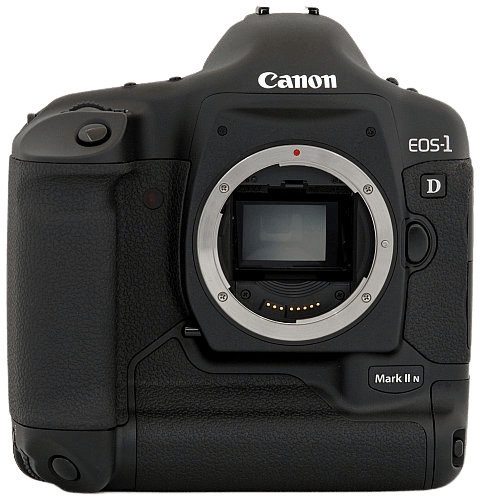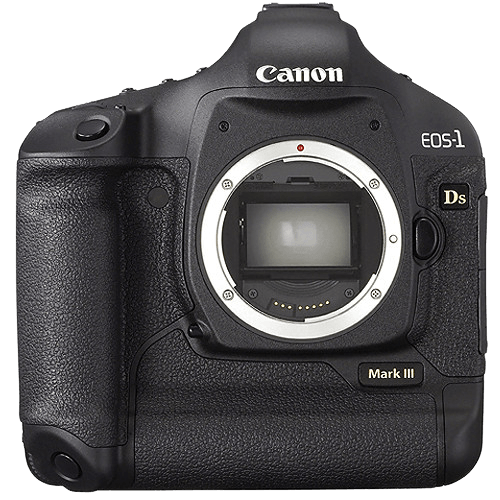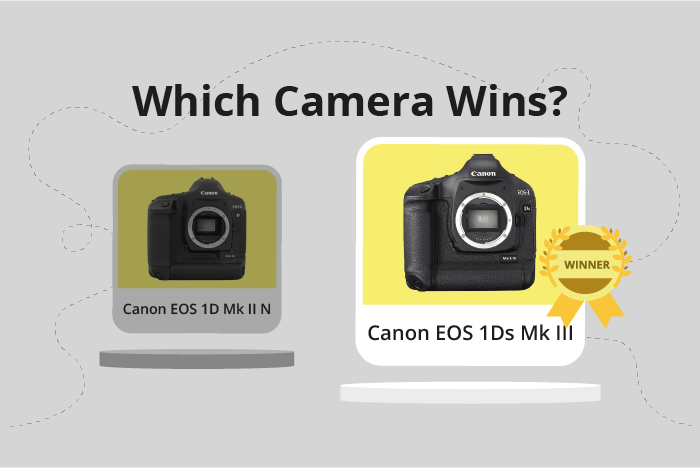Canon EOS 1D Mark II N vs EOS 1Ds Mark III Comparison
Canon EOS 1D Mark II N

Canon EOS 1Ds Mark III

The Canon EOS 1Ds Mark III emerges as the winner with a score of 58/100, while the Canon EOS 1D Mark II N trails behind with a score of 40/100. Both cameras share common specifications, such as being DSLRs and having similar dimensions (1Ds Mark III: 150 x 160 x 80mm; 1D Mark II N: 156 x 158 x 80mm).
The 1Ds Mark III has the advantage of a more recent release year (2007) and a lighter weight (1385g / 3.05lbs) compared to the 1D Mark II N (2005, 1565g / 3.45lbs). This makes it more advanced and easier to handle. The 1D Mark II N, however, has a lower launch price ($5986) than the 1Ds Mark III ($7100), making it a more affordable option.
Taking into account these factors, the Canon EOS 1Ds Mark III’s higher score reflects its superior features and performance, while the Canon EOS 1D Mark II N offers a more budget-friendly option for those who value affordability over the latest technology.
Canon EOS 1D Mark II N vs EOS 1Ds Mark III Overview and Optics
The Canon EOS 1Ds Mark III comes out on top in the optics comparison, with a score of 60/100, while the Canon EOS 1D Mark II N scores 46/100. Both cameras share some common specifications, including the use of a CMOS sensor, Canon EF lens mount, and the absence of image stabilization.
The 1Ds Mark III has a clear advantage in terms of image quality, with a higher resolution of 21.1 megapixels compared to the 8.2 megapixels of the 1D Mark II N. This allows the 1Ds Mark III to capture more detail and produce larger prints. Additionally, the 1Ds Mark III has a higher DXOMARK sensor score of 80, compared to 66 for the 1D Mark II N, which means it performs better in low light and has a wider dynamic range. Furthermore, the 1Ds Mark III features a full-frame sensor, which is larger than the APS-H sensor found in the 1D Mark II N, resulting in better image quality and improved low-light performance.
On the other hand, the 1D Mark II N has a faster shooting speed of 8.5 frames per second, compared to 5 frames per second on the 1Ds Mark III. This makes the 1D Mark II N more suitable for action and sports photography.
Considering these factors, the Canon EOS 1Ds Mark III is the superior camera in terms of optics, thanks to its higher resolution, better sensor performance, and full-frame sensor. However, the 1D Mark II N may be more suitable for certain situations, such as action photography, due to its faster shooting speed.
Canon EOS 1D Mark II N vs EOS 1Ds Mark III Video Performance
In discussing the video capabilities of the Canon EOS 1D Mark II N and Canon EOS 1Ds Mark III, it is important to note that neither camera possesses video functionality. As such, there is no comparison to be made in terms of video capabilities for these two models. The lack of video functionality does not affect the overall quality of the cameras, as their scores are determined by other factors, such as general specifications and optics.
Canon EOS 1D Mark II N vs EOS 1Ds Mark III Features and Benefits
The Canon EOS 1Ds Mark III triumphs over the Canon EOS 1D Mark II N in features, with a score of 49/100 compared to 17/100. Both cameras share some similarities in their specifications, such as screen resolution at 230,000 dots, lack of a touchscreen, absence of a flip screen, and no GPS or Bluetooth capabilities.
The Canon EOS 1Ds Mark III outperforms the Canon EOS 1D Mark II N with its larger screen size of 3 inches, compared to the latter’s 2.5 inches. Additionally, the 1Ds Mark III offers Wi-Fi connectivity, which the 1D Mark II N does not have. This feature allows users to transfer images and remotely control the camera, providing more convenience and flexibility.
On the other hand, the Canon EOS 1D Mark II N does not have any distinct advantages over the Canon EOS 1Ds Mark III in terms of features. Both cameras have the same screen resolution, and neither has a touchscreen, flip screen, GPS, or Bluetooth. The 1D Mark II N has a smaller screen size and lacks Wi-Fi connectivity, which makes the 1Ds Mark III a superior choice in this comparison.
Taking into consideration the feature scores and specifications, the Canon EOS 1Ds Mark III is the better camera when compared to the Canon EOS 1D Mark II N. Its larger screen size and Wi-Fi capabilities make it a more convenient and user-friendly option for photographers. The absence of any significant advantages in the 1D Mark II N further solidifies the 1Ds Mark III as the preferable choice among the two cameras.
Canon EOS 1D Mark II N vs EOS 1Ds Mark III Storage and Battery
The Canon EOS 1Ds Mark III wins in storage and battery with a score of 84/100, while the Canon EOS 1D Mark II N scores 79/100. Both cameras have two memory card slots, accepting SD and Compact Flash (Type I or II) cards. USB charging is not available for either camera.
The 1Ds Mark III outperforms the 1D Mark II N in battery life, offering 1800 shots compared to 1200 shots. This difference is significant for extended shooting sessions. The 1Ds Mark III also uses the LP-E4 battery type, while the 1D Mark II N utilizes the NP-E3.
However, the 1D Mark II N does not have any advantages in storage and battery over the 1Ds Mark III. The 1Ds Mark III is the clear winner in this category, providing a longer battery life for users who need the additional capacity.
Canon EOS 1D Mark II N vs EOS 1Ds Mark III – Our Verdict
Are you still undecided about which camera is right for you? Have a look at these popular comparisons that feature the Canon EOS 1D Mark II N or the Canon EOS 1Ds Mark III:

